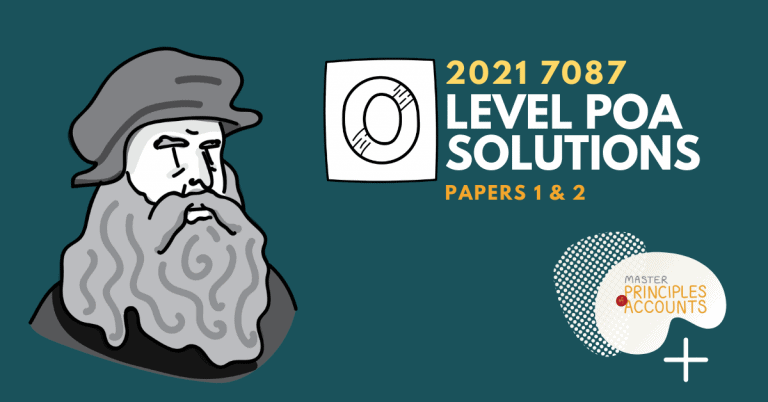2017 O Level POA Answers Paper 2
Jason chin
Statement of financial performance for the year ended 30 April 2019
| $ | $ | |
| Sales revenue (92385 – 195) | 92190 | |
| Less: sales returns | 780 | |
| Net sales revenue | 91410 | |
| Less : cost of sales | 64570 | |
| Gross profit | 26840 | |
| Add: Other Income | ||
| Gain on sale of non-current asset | 195 | |
| Less: Other Expenses | ||
| Rent | 3500 | |
| Wages and salaries | 8000 | |
| General expenses (2000 + 625) | 2625 | |
| Discount allowed | 252 | |
| Insurance (450 x 12/15) | 360 | |
| Loan interest (7500 x 5%) | 375 | |
| Impairment loss on trade receivables (500 – 300) | 200 | |
| Depreciation on equipment (28000 x 10%) | 2800 | |
| Depreciation on motor vehicles ((45000 – 16200) x 20%) | 5760 | |
| 23872 | ||
| Profit for the year | 3163 |
Jason Chin
Statement of financial position as at 30 April 2019
| Assets | $ | $ | $ |
| Non-current asset | cost | Acc. dep. | N.B.V |
| Equipment | 275000 | 82500 | 192500 |
| Motor vehicles | 48000 | 27750 | 20250 |
| Total non-current assets | 212750 | ||
| Current assets | |||
| Inventory | 32300 | ||
| Trade receivables | 30700 | ||
| Less: allowance of impairment on trade receivables | (650) | 30050 | |
| Prepaid rent | 6000 | ||
| Total current assets | 68350 | ||
| Total assets | 281100 | ||
| Equity and liabilities | |||
| Shareholder’s equity | |||
| Issued share capital, 300,000 ordinary shares | 150000 | ||
| Retained earnings (40625-15000+21400) | 51675 | ||
| Total equity | 201675 | ||
| Non-current liabilities | |||
| Long term borrowings (35000-5000) | 300000 | ||
| Current liabilities | |||
| Trade payables | 20900 | ||
| Bank overdraft | 6300 | ||
| Wages and salaries payable | 1350 | ||
| Current portion of long term borrowings | 5000 | ||
| Interest on bank loan payable (3500-2625) | 875 | ||
| Dividends payable (300000x$0.05) | 15000 | ||
| Total current liabilities | 49425 | ||
| Total equity and liabilities | 281100 |
a) Liquidity is the ability of the business to convert assets to cash to meet its current obligation.
b)
| 2016 | 2017 | |
| Working capital ratio | 58400/20500= 2.85 | 68500/36230= 1.89 |
c) The working capital ratio is on a declining trend from 3.62:1 in 2015 to 2.85:1 in 2016 to 1.89:1 in 2017. This is mainly due to the larger increase in current liabilities as compared to the increase in current assets.Basing on the working capital ratio calculated, Jennifer should be able to pay the debts when they are due. However, as the majority of the current assets is made up inventory which is a non-liquid assets, she might face difficulty to pay the current liabilities especially in 2017.Increasing trend in inventory holding tied up cash, increase trend in trade receivables might result in impairment loss, decreasing cash balances and eventual goes into bank overdraft in 2017 might be the cause for the increasing trend in trade payables and finally the long-term borrowings payable within a year.
d) Profit is derived from income earned less expenses incurred for the period. It will not be affected by collection and payments. Whereas, liquidity calculation used current assets and current liabilities. Therefore, profit or loss has not impact on liquidity as only the movement in current assets and current liabilities will have impact on liquidity.
e) Two profitability ratios
- gross profit margin
- profit margin
ai) Retained earnings is the accumulated profits over the years that has not been distributed to shareholders.
aii) Dividends is the distribution from the retained earnings to shareholders.
b) Shareholders equity will be affected by:
- additional shares issued during the year
- profit or loss during the year
- dividends declared during the year
c)
General journal
| Date | Particulars | Dr | Cr |
| 2017 | $ | $ | |
| Apr 30 | Cash at bank (50000 x $1.50) | 75000 | |
| Issued share capital | 75000 | ||
| Being receipt from issue of ordinary shares at $1.50 each. |
d)
Retained earnings account
| Date | Particulars | Dr | Cr | Bal |
| 2016 | $ | $ | $ | |
| Jul 1 | Balance b/d | 175000 Cr | ||
| 2017 | ||||
| Jul 30 | Profit and loss | 75000 | 250000 Cr | |
| 30 | Dividends (250000 x $0.10) | 25000 | 225000 Cr | |
| Jun 1 | Balance b/d | 225000 Cr |
a)
Trade payables control account
| Date | Particulars | Dr | Cr | Bal |
| 2017 | $ | $ | $ | |
| Jul 1 | Balance b/d | 9845 Cr | ||
| 31 | Discount received | 324 | 9521 Cr | |
| 31 | Cash at bank | 10245 | 724 Dr | |
| 31 | Inventory | 15382 | 14658 Cr | |
| 31 | Inventory | 720 | 13938 Cr | |
| 31 | Interest | 105 | 14043 Cr | |
| Jun 1 | Balance b/d | 14043 Cr |
b) Interest charge should appear under expenses in the statement of financial performance.
c) Usage of a trade payables control account :
- to prevent overcrowding in general ledger.
- to serve as an accuracy check against the purchase ledger.
d) Cash discount might be received to encourage prompt payment.
a) Cost of sales for August 2017 = $1800 + $650
= $2450
b) Value of inventory at 29 August 2017 = $5935 + $2450
= $3485
c) Revised value of inventory at 31 August 2017 = $1625 + $1600
= $3225
d)
General journal
| Date | Particulars | Dr | Cr |
| 2017 | $ | $ | |
| Aug 31 | Impairment loss on inventory (1860 – 1600) | 260 | |
| Inventory | 260 | ||
| Being loss on inventory revaluation for goods purchased on 29 August 2017. |
e) Net realisable value is the estimated selling price less any additional cost required to make the sale.
f) Prudence concept.


